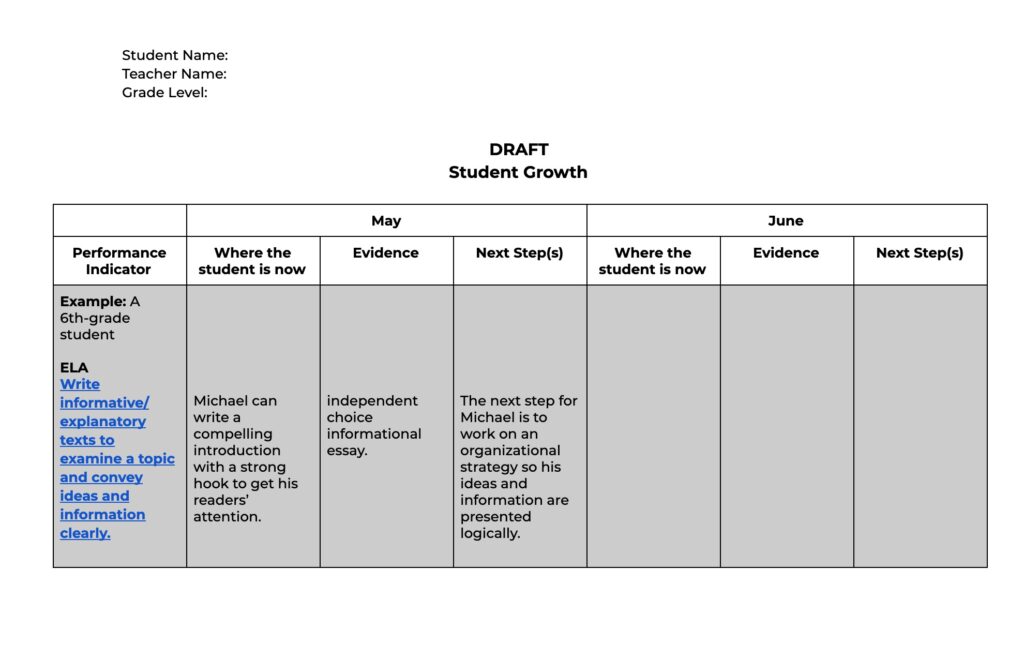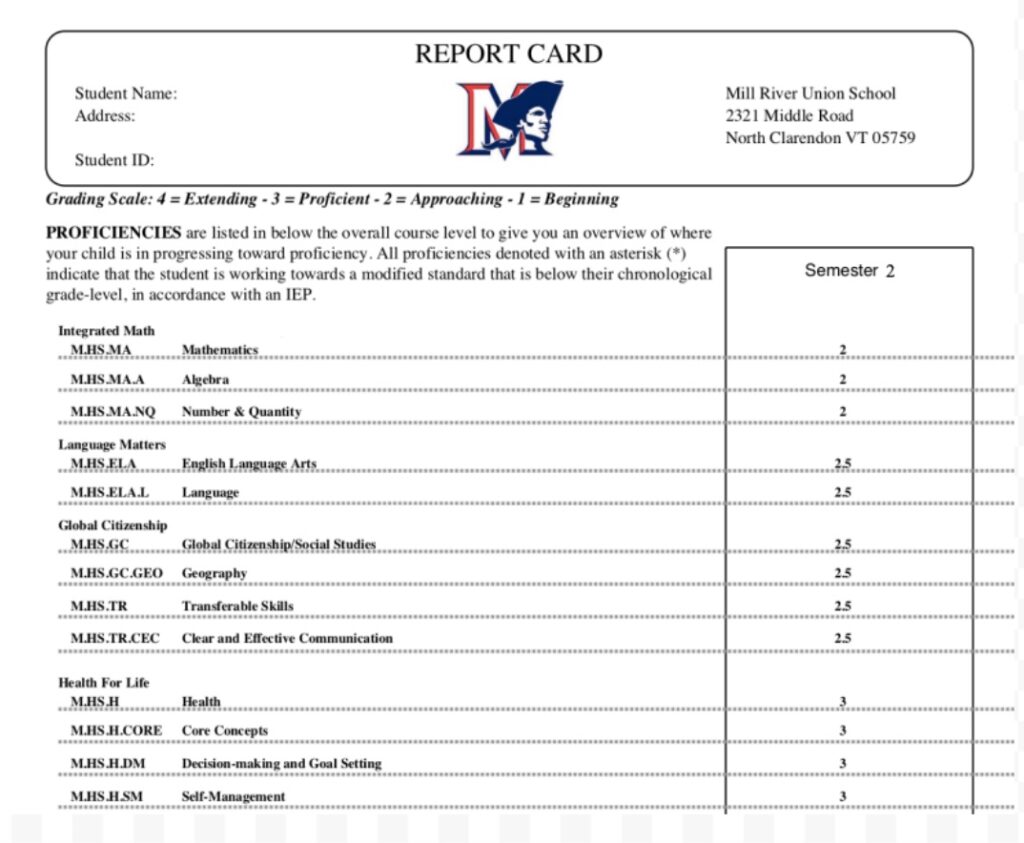In spring 2020, during statewide “emergency remote learning” due to the pandemic, many districts and schools changed their approach to grading and reporting.
The shift was toward a “do no harm” model. In a moment when everybody was reeling from ongoing collective trauma and uncertainty, this made a lot of sense from a purely human standpoint. And with so much variation in student access to technology and other resources, evaluations of performance were bound to be hugely inequitable.
The report cards that families received often looked quite different than in the past. In many cases there were no letter or number grades. Often there were narrative comments and feedback that was new or more detailed than before. And the emphasis was likely to be on student assets, growth, and encouragement.
So how about now? Are these shifts still in place or are we snapping back to pre-pandemic practices? The answer is a bit of both.
Why should grading change?
When some schools let go of letter and number grades last spring, there was an understanding that these seemingly precise measures were crude representations of learning. In the midst of collective trauma, and with so many variables at play, it seemed unnecessarily reductionist to quantitatively summarize students’ experiences.
Yet doesn’t this logic extend beyond the pandemic? Evaluating a student with a number pulls them into a paradigm of comparison. And comparison begets competition. Winners and losers, rather than growers and learners.
In a recent article, Tony Winger and Kimberly Race trace the costs of grading, which include teachers acting as gatekeepers for success, the proliferation of fixed mindsets, and the toll it takes on students’ wellbeing. They cite research showing grades as the biggest factor, by far, in students’ stress levels.
We don’t want to produce undue anxiety. But perhaps this stress is justified because it motivates students to learn? Unfortunately the extrinsic motivation of grades is not a solid motivator for the long term.
Fundamentally, though, grading and reporting reflect our beliefs about the purpose of schooling. As Winger and Race ask: “Do we wish to serve as gatekeepers, sorting and ranking students as they compete for status and resources? Or do we wish to help all students grow to be healthy and happy humans, self-sufficient and creative workers, collaborative problem solvers, and engaged citizens?”
For those pushing school systems to become more equitable and student centered, the choice is clear. Grades gotta go.
Why are grades sticking around?
Based on interviews with several districts for this blog post, it appears that report cards in Vermont this fall will look very similar to how they appeared before the pandemic.
There seemed to be a near consensus among instructional leaders that the long term vision was to ditch grades and focus entirely on narrative feedback. Especially at the elementary and middle levels.
And there was unanimous agreement that the main barrier for going grade-less was culture. The culture of our society in general and of our schools in particular. Families simply aren’t ready for this shift. Especially certain privileged families that want to maintain their competitive advantage.
Andrew Jones is the Curriculum Director of Mill River Schools and President of the Vermont Curriculum Leaders Association. He visited several schools in Maine near the end of 2019 as a follow up to visits he had done during his Rowland Fellowship five years prior. He wanted to understand why Maine had reversed course legislatively on Standards Based Grading.
“For schools where there was a big pushback on proficiencies, we found that letter grades were the thing that broke it. Some schools changed practices and did fine, but schools that changed the outside facing stuff, that’s what sank it. I talked to somebody who sat in every legislative hearing, and it was all about letter grades, transcripts, and colleges.”
Logistics too
The transition from high school to college is the ultimate sticking point. There is a logistical dilemma of how to transfer information so that colleges can run an admissions process. There are some models emerging but they are not yet proven or widespread.
In her article A Perfect World is One with No Grades, Susan Brookhart noted that “administrative functions that come with doing education at scale” may require some level of sorting and ranking. Even a strong proponent of going gradeless like Brookhart acknowledged that doing so at a systems level may be a bridge too far at the moment.
Some promising shifts
There may not be dramatic changes to report cards this year. But instructional leaders around the state are adamant that proficiency based learning practices have accelerated. Here are a few areas that jumped out across several interviews:
Narrative reporting
Grades in the form of letters or numbers are still present. But the emphasis on descriptive narratives from the spring has carry over benefits.
In Two Rivers Supervisory Union, teachers engaged in the “GPS model of feedback,” so called by the former Curriculum Director Michael Eppolito. “What’s your goal? Where are you now? And what’s your next step?” Teachers wrote a Student Growth Report for progress reports in the spring and at the end of the year. This practice allowed them to “change their practice and move toward a more proficiency based mindset,” according to Michael.
Mike Moriarty, Curriculum Director of Orleans Central Supervisory Union (OCSU), similarly cited the benefits of teachers experiencing a full cycle of purely narrative reporting. Although OCSU will be bringing back their 1-4 scale on performance indicators for this year, they are keeping the narratives. “We received a lot of positive feedback in the spring about our reporting and about overall communication with families. We are going to build on that this year.”
Guaranteed and viable curriculum
Many districts reduced the amount of content that teachers are being asked to cover.
As described by Jal Mehta, Harvard professor and co-author of a prominent paper on creative solutions to schooling during the pandemic, “The key idea is to just focus on the essential knowledge and skills that kids need to learn in a given year, and then let go of some of the rest… Focusing on essentials allows opportunities for teachers to go deeper, create space to form relationships, build communities, support social emotional learning, extracurriculars, and all the other things that are going to be critical in this upcoming year.”
Andrew Jones noted that “it is absolutely crucial that we get to a guaranteed and viable curriculum. That we set a limited number of learning targets that we can realistically teach and assess in a school year.” Emily Rinkema, instructional coach at Champlain Valley Union High School, pointed to this as a major shift: “all courses have reduced the number of learning targets… Last year, full credit courses had between 8-12 learning targets; this year, they have between 4-6 learning targets.”
Fewer learning targets = more depth. And that’s a good thing.
Beyond content knowledge
Transferable Skills have been part of the plan for implementing proficiencies since the passage of Act 77 in 2013. Reducing the amount of content that needs to be covered opens up time and energy to incorporate Transferable Skills meaningfully.
In addition to Transferable Skills, Emily Rinkema explained how the pandemic brought socio-emotional learning (SEL) to the fore. “Teachers are so much more focused on SEL and have been willing and eager to let go of some of the things they worried about in the past. For example, there was a lot of talk last year pre-pandemic about how we can ‘grade’ executive functioning. And now, they are more interested in how to support executive functioning skills.”
Orleans Southwest Supervisory Union (OSSU) is putting SEL at the center of professional learning this school year. Superintendent Adam Rosenberg noted that, “We worked hard to lay the SEL foundation at the beginning of the school year with the understanding that it’s not just for two weeks and then move on, but that these strategies will become habits of practice.”
Student-centered instructional models
Teachers moved mountains in the spring to transform instruction at the drop of a hat. Instructional leaders are hoping to build on some of the successes that emerged in those extremely challenging circumstances.
Mill River Schools has started the year fully remote. Curriculum Director Andrew Jones has asked teachers to organize instruction using flexible learning modules. These are one week cycles that end in a “formal formative assessment” which guides remediation and enrichment. Modules are developed using a common template to make things easier to follow for students and families. The focus is on feedback and student growth, which Andrew expects will continue with face-to-face learning.
In OSSU, although most students opted into face-to-face learning, Superintendent Adam Rosenberg asked teachers to “teach all students through the lens of remote learning.” The district had been working on “cultivating learner agency through reflective practice” for some time, but serving students remotely has strengthened the rationale for putting student self-direction and agency at the center. The district’s recently developed Learner Agency Teacher Rubric is being used for reflection and collective implementation in a way that is beyond where the conversation likely would have been otherwise.
Onward
While grading and reporting may not look hugely different than a year ago, there seems to be movement in the right direction with some acceleration in key areas. It is worth noting that many often cited “best practices” are already fairly widespread practices in Vermont. It is common to find learning scales, opportunities for retaking assessments, and separate evaluation of Work Habits from academics.
In a recent article Tom Schimmer emphasized the incremental nature of changes in these areas: “Grading reform doesn’t happen overnight; we aren’t simply going to snap out of habitual practices… Short-term wins can add up to a seismic shift in grading and reporting.”
Andrew Jones pointed to eight years of implementation as a threshold where “the real work can begin.” From conversations with schools in Maine, Washington, and Oregon, he consistently heard that it took about that long for communities to get past active resistance to the transformations inherent in authentic proficiency based learning.
By that measure, most Vermont districts have a few years of this first phase of implementation. If we keep moving steadily ahead, hopefully the culture of schooling will reach a point where equitable gradeless feedback rich practices are not only accepted, but expected.




